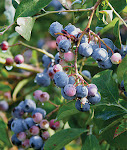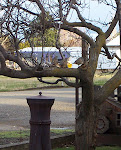Well something is enjoying my little Paw Paw trees and I'm not happy about it! The leaves must be tasty to some bug! I'll need to protect them from now on, with some organic spray and maybe even netting. Want to give them a fair chance of surviving here, outside of their usual growing range.
When I bought the two, little trees they were (literally) just sticks with a couple of roots! They are now about a foot tall and have been transplanted into 1 gallon pots. With the exception of the munched on leaves, they are both doing very well! Looking forward to spring 2019, to see how they make it through another cold winter.
Upon further investigation, it seems that it might be Japanese Beetle. However, there is good news too! After doing a bit of research this is what I've found: Pawpaw plants produce natural compounds in their leaf, bark, and twig tissue that has high anti-pesticidal properties. Because of this natural defense, and because pests that are attracted to the plant rarely do significant damage, treating pawpaw pests is generally unnecessary.

















